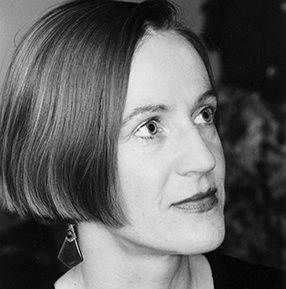Almost time to dress for the sun's total eclipse
so the child pastes one last face
in her album of movie stars – Myrna Loy
and Olivia de Havilland – names meant to conjure
sultry nights, voluptuous turns across
some dance floor borne on clouds. Jean Harlow.
Clipped from the Newark evening paper, whole galaxies
of splendid starlets gaze, fixed to violet pages
spread drying on the kitchen table. The child whispers
their names when she tests “lorgnettes”
made that morning out of shirtboards, old film
negatives gleaned from her grandmother’s hat box.
Through phony opera glasses, hall lights blur
stained sepia above her, and her grandmother’s
room is stained by a tall oak’s crown, yellow
in the window. Acorns crack against asphalt
three floors down. The paper promised
“a rare conjunction of sun and moon and earth.”
Her grandmother brushed thick gray hair.
Cut glass bottles and jewel cases.
Above the corset her back was soft, black moles
she called her “melanomas” dusted across
powdery skin like a night sky, inside out.
The Spanish fan dangles from her wrist
and when she stands she looks like an actress
from the late-night movies. The child sifts
costume brooches, glass rubies and sapphires,
to find the dark gold snake ring with emerald chips
for eyes. She carries the miniature hourglass
to the sagging porch, then waiting turns it over
and over. Uncertain in high heels, she teeters
and the shawl draped flamenco-style keeps sliding off
her shoulder, so she glances up the block to Girl Scouts
reeling down the flag. The child hates their dull uniforms,
how they scatter shrieking through leafsmoke and the sheen
of fallen chestnuts. She touches the ring, heavy
on a ribbon circling her neck, then thinks she’ll sew
the album pages with green embroidery silk.
Her grandmother snaps the fan and they raise lorgnettes
to the sun’s charcoaled face, its thin wreath
of fire. Quiet, the Girl Scouts bow their heads – sleek
Italian ones and black girls with myriad tight braids.
Streetlights hum on, then the towers of Manhattan flare
beyond the river. The earth must carve its grave ellipse
through desert space, through years and histories
before it will cross with sun and moon this way again.
Minor starlets in the child’s album will fade and tatter,
fleeting constellations with names flimsy as
the shawl that wraps her shoulders. She’ll remember this
as foolish. The girls by the flag will mostly leave
for lives of poverty, crippled dreams, and Newark
will collapse to burn like another dying star.
But none of this has happened. Afternoon has stilled
with the eclipse that strips them of their shadows,
so each one stands within their own brief human orbit
while the world reverses, then slowly, recovers.
From the book Star Ledger published by University of Iowa Press © 1991 by Lynda Hull. Used with permission. All rights reserved.

